March 2024
- English
- 日本語
Technology Inherited from Japan Supports the Maintenance of Democratic Republic of the Congo's Matadi Bridge
-
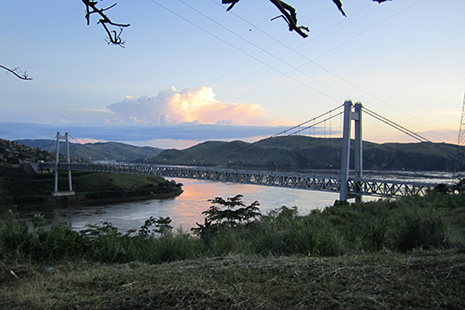
2023 marked the 40th anniversary of the Matadi Bridge's opening.
Photo: Yuzuki Seiji -
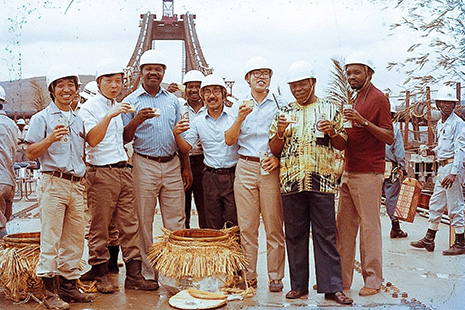
Staff from Japan and OEBK celebrate the completion of construction.
Photo: Tatsumi Masaaki
-
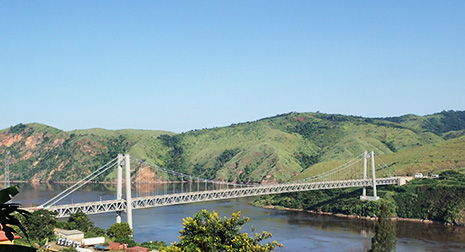
The Matadi Bridge opened in 1983.
Photo: JICA -
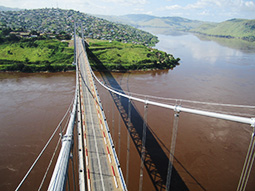
The deck of the Matadi Bridge. (Photo taken in 2014.)
Photo: Yuzuki Seiji -
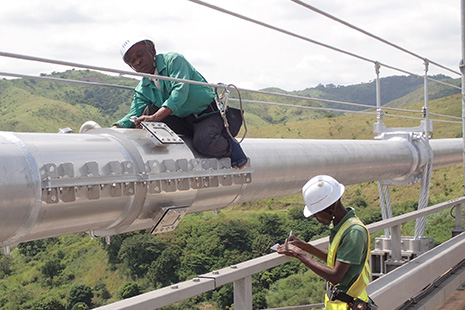
Local staff inspect the bridge using maintenance techniques learned from Japanese specialists.
Photo: IHI Infrastructure System Co., Ltd.

Photo: Yuzuki Seiji
Located in Africa about 150 km inland from the Atlantic Ocean, just downriver from the port of Matadi in the Democratic Republic of the Congo (DRC), the Matadi Bridge is a suspension bridge that was constructed in an international cooperation project carried out by Japan. We conducted an interview to find out more about this bridge, which is the only fixed crossing over the lower or middle stretches of the Congo River.
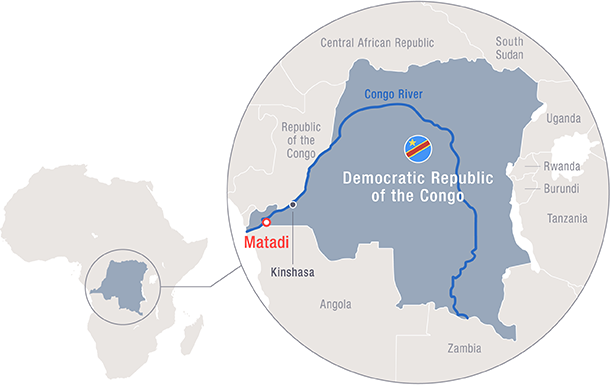
Tatsumi Masaaki, a technical adviser to Oriental Consultants Global Co., Ltd., who took part in the support project that constructed the Matadi Bridge in the DRC, explained the background of the project to us.
"From the eastern DRC into Zambia is a region called the Copperbelt* that is rich in mineral resources. In 1971, when then-President Mobutu was hoping to enable integrated transport of these mineral resources to ports on the Atlantic Ocean, then-Prime Minister of Japan Sato Eisaku agreed to provide support. The construction of the Matadi Bridge was part of this transport plan."
Featuring a total length of 722 meters and a main span of 520 meters, the Matadi Bridge was designed to incorporate a roadway on the upper deck and a railway below. The Organization for Equipment of Banana-Kinshasa (OEBK) was established in affiliation with the country's National Transport Office.
"A total of 74 JICA specialists from organizations including the then-Japan National Railways (JNR), the then-Honshu-Shikoku Bridge Authority, and the then-Japan Railway Construction Public Corporation (JRCC) were dispatched to OEBK during the periods of preparation, construction, and initial maintenance of the bridge."

Photo: JICA
Construction began in 1979, bringing together a range of the latest technologies from Japan, and finished in 1983, the year the bridge opened.
"In Japan, while the Matadi Bridge project was in the planning stage, research on technical challenges with planning and construction in the Honshu-Shikoku Bridge Project was being carried out in cooperation between industry, government and academia. (See: Seto Ohashi Bridge — The Dream Bridge That Connects Honshu with Shikoku). The Matadi Bridge had features in common with the Shimotsui Seto Ohashi span, which makes up part of the Seto Ohashi Bridge, including their suspension bridge forms and their sites' geographical features, so a similar design was adopted for it. This included a structure incorporating both a railway and roadway, as well as a design as a suspension bridge spanning the river where the waterway was narrow. Also, the results of technical research conducted as part of the Honshu-Shikoku Bridge Project, such as approaches to ensuring a wind-resistant design, were utilized everywhere in the bridge's design."

Photo: Yuzuki Seiji
Despite the large-scale of the bridge construction project, the build time came in 14 months quicker than originally scheduled, earning high acclaim for the project.
"One of the main factors allowing the shorter construction time was that the Japanese companies responsible for carrying out the project employed cutting-edge construction equipment. Also, at the same time, the work of the locally hired tobishoku** construction workers greatly contributed to the success as well, I would say. This was when the peak construction period for the Seto Ohashi bridge construction project in Japan was approaching, so we even joked about wanting to bring these great workers back to Japan with us."

Photo: Tatsumi Masaaki
The work of the Congolese OEBK engineers who were responsible for the actual operations was outstanding, as well.
"For about 20 years, after riots broke out in Kinshasa in 1991, on-site support from Japan stopped. During this period, the Matadi Bridge was maintained mainly by Mr. Madiata and Mr. Kalombo, the leading local engineers. I revisited the site myself when Japanese support resumed in 2012, to inspect the cables. The bridge had been repainted and looked the same as when it was newly constructed. It really impressed me to see how wonderfully it had been maintained. This is a testimony to their passion for maintaining the bridge and the patient effort they put into the work."

Photo: IHI Infrastructure System Co., Ltd.
In June 2023, a ceremony celebrating the 40th anniversary of the Matadi Bridge's construction was held in a commemorative park on the right bank of the Congo River.
"While the people who were involved with the project at the time have mostly moved on from the site, I earnestly hope that young Congolese and Japanese engineers will maintain communication with each other and continue to collaborate on this project, so that in the future the 50th and even 100th anniversary of this symbol of friendship between the Congo and Japan, the Matadi Bridge, can be celebrated as well."
* A region about 500 km long and 80 km wide extending from the southern African country of Zambia into the Democratic Republic of the Congo. Contains some of the richest copper ore deposits in the world. The region is estimated to contain more than 10% of the world's land-based copper resources.
** A term for workers in the Japanese construction industry who specialize in carrying out work in high locations. Also referred to as tobi, tobi no mono, and tobi-ko.

